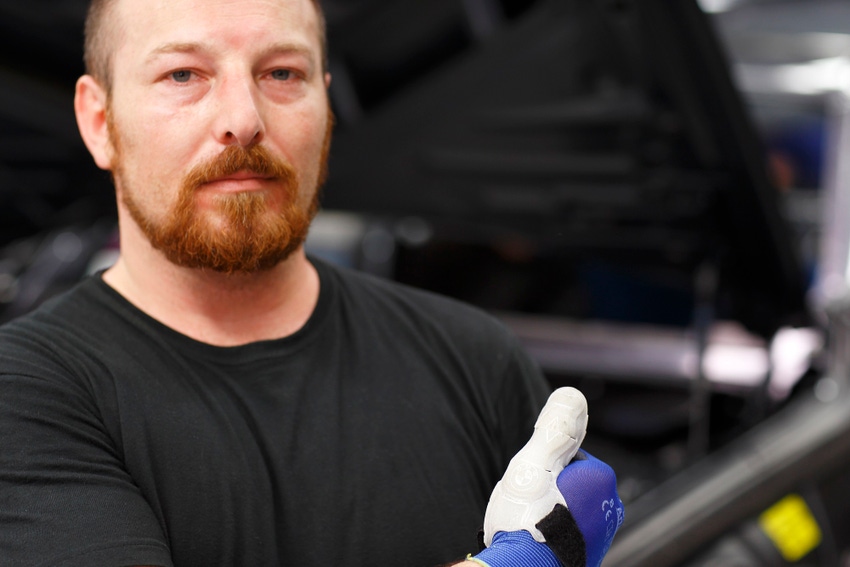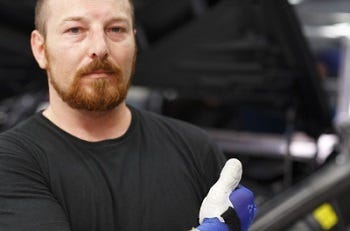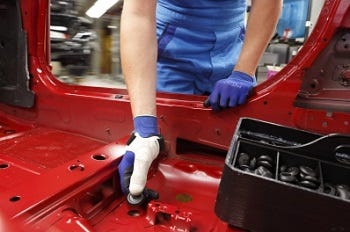Thumbs up! 3D-printed finger cots support the assembly process at BMW
Occupational health and safety has been further enhanced on the assembly floor at BMW through the use of customized flexible finger cots fabrication from thermoplastic polyurethane (TPU) using 3D printing.Manufactured in-house at BMW and customized to the shape of individual worker's fingers, the orthotic device is worn over the thumb to provide protection against excessive strains on the thumb joints when carrying out assembly processes such as insertion of rubber plugs into bodywork.
July 1, 2014

Occupational health and safety has been further enhanced on the assembly floor at BMW through the use of customized flexible finger cots fabrication from thermoplastic polyurethane (TPU) using 3D printing.
Manufactured in-house at BMW and customized to the shape of individual worker's fingers, the orthotic device is worn over the thumb to provide protection against excessive strains on the thumb joints when carrying out assembly processes such as insertion of rubber plugs into bodywork.
|
Thumbs up for finger protection on the BMW assembly line. |
|
These have to be pressed in with the thumb to close holes such as those employed in car bodies to allow paint to drain away during the coating process. And even for people with strong hand muscles, this movement requires a certain effort.
In order to prevent unnecessary overstretching of the thumb joint, the finger cot made of TPU is placed over the thumb like a second skin. Right at the thumb joint, the assembly aid is open to allow the thumb to move without restriction. At the back of the thumb, though, the plastic material is reinforced. If the thumb is stretched, as in a 'like it' gesture, the reinforced elements come into contact, forming a stable splint. In this manner, the effort needed to press in the plug is spread across the entire thumb, down to the carpus.
In initial practical tests, the feedback of workers was very positive. Currently, BMW is evaluating how the assembly aids can be applied as standard tools in other production areas.
In fabrication of these finger cots, each worker's thumb is measured with a mobile 3D hand scanner. Based on a standard production layout, the orthotic devise is then computed and divided virtually into individual layers. Layer by layer, each of them about as thick as a human hair, the devices is then manufactured in a selective laser sintering process.
TPU, the material used, is said to be perfectly suited to making flexible orthotic devices. As a rule, it is elastic, but it can form solid and rigid combinations at higher material strengths. The mechanical tensile strength is high, ensuring that the material can resist strong, continuous strains without tearing.
This is not the first time that the BMW Group is applying its expertise in additive production procedures to making ergonomic aids. One example: Back in 2012, the automotive manufacturer produced customized wheelchair seats for the British basketball team competing in the Paralympics. Compared to conventionally made seats, the innovative seats were considerably lighter and also an ideal fit for the athletes.
The BMW Group has applied additive production procedures for rapid prototyping in concept prototyping since 1989. Besides selective laser sintering, processes employed include stereo-lithography, polyjet printing, fused deposition modelling, and stream smelting of metals. The Rapid Technologies Center at the BMW Group's Research and Innovation Center (FIZ) in Munich produces close to 100,000 components a year using these methods. The range includes anything from small plastics holders to design patterns and vehicle components for functional tests.
Depending on the procedure and the size of the component, components might be available within only a few days. They are applied in vehicle development and testing, as well as in high-strain sections in the BMW Group's DTM (German Touring Car Masters) racing cars, among other areas.
The finger cot pilot project at the company's Munich vehicle assembly plant is part of a is part of a dissertation in cooperation with the Department of Ergonomics at the Technical University of Munich.
About the Author(s)
You May Also Like




